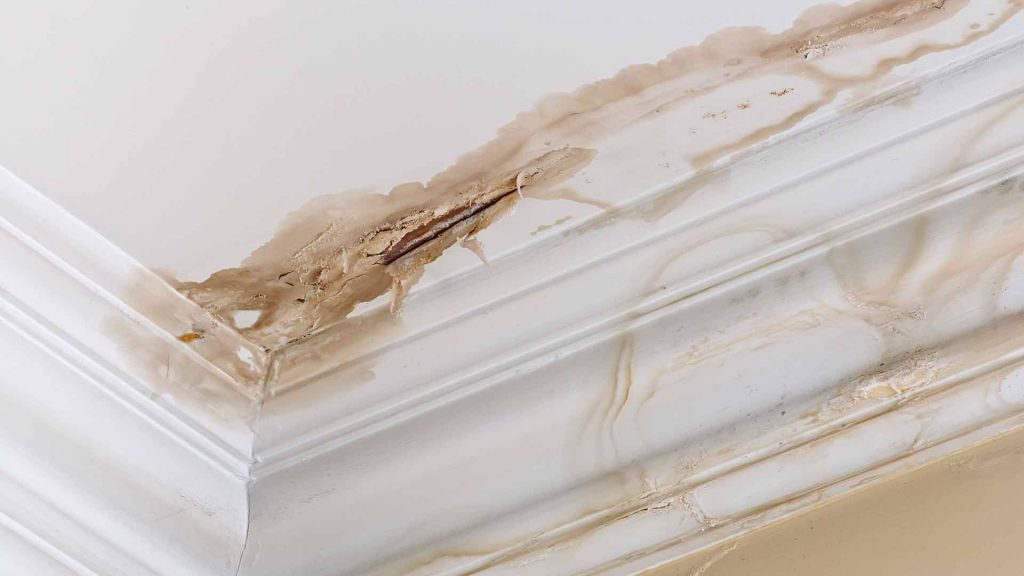Roof Flashing Leaks
One of the most common problems that homeowners face is roof leaks. In fact, according to a study by the Insurance Institute for Business & Home Safety, roof leaks are the second most common type of residential water damage claim. There are many different causes of roof leaks, but one of the most common is flashing leaks. Flashing is the strip of metal or other material that is installed around vents, chimneys, and skylights on your roof. Over time, these things can loosen and allow water to seep in, causing damage to your home. In this blog post, we will explore the causes of roof flashing leaks and how you can prevent them. We will also provide some tips on what to do if you already leak.

What is Roof Flashing?
Roof flashing is a material installed around protrusions on a roof, like vent pipes and skylights. Its purpose is to direct water away from these vulnerable spots so that it doesn’t seep into the home.
There are two types of roof flashing:
-Exposed, which is visible on the roof line, and
-Hidden, which is tucked under the shingles.
Both types are susceptible to leaks if they’re not installed properly or if they become damaged. Over time, exposure to the elements can cause the material to degrade, making it more likely to fail.
To prevent leaks, it’s important to have a professional inspect and install your roof flashing. And if you do find a leak, don’t delay in getting it fixed—the sooner you take care of it, the less damage will be caused.
Common Causes of Roof-Flashing Leaks
One of the most common causes of roof flashing leaks is improper installation. Flashing should be installed so that it extends at least 2 inches up the roofing material and over the top edge of the shingles. It should also be nailed or screwed down securely.
Another common cause of roof flashing leaks is poor maintenance. If your flashing is not kept clean and in good repair, it can develop leaks. Make sure to inspect your flashing regularly and repair any damage that you see.
Finally, weather can also be a factor in roof flashing leaks. Heavy winds can loosen nails or screws while driving rain can wash away mortar or sealant. If you live in an area with severe weather conditions, make sure to check your flashing frequently and repair any damage that you see.
How to Prevent Roof-Flashing Leaks
Preventing roof flashing leaks is essential to keeping your home in good condition. Flashing is the metal or plastic strip that is installed along your roofline and at other vulnerable points on your roof. Over time, flashing can become loose or damaged, allowing water to seep in and cause damage to your home.
There are a few things you can do to prevent roof flashing leaks:
-Inspect your flashing regularly and look for any signs of wear or damage. If you see any damage, replace the damaged section immediately.
-Make sure that your gutters are clean and free of debris. Clogged gutters can cause water to back up under your shingles and flashings.
-Trim trees and shrubs near your home so that they aren’t touching your roof. Overhanging branches can damage flashings and allow water to get under your shingles.
If you take these steps to prevent roof flashing leaks, you’ll be much less likely to have to deal with water damage in your home.
Types of Roof Flashing
There are three main types of roof flashing: metal, shingle, and roll. Metal flashing is the most common type of roof flashing. It is made of galvanized steel or aluminium and is installed over roofing materials to direct water away from vulnerable areas. Shingle flashing is made of asphalt-saturated felt and is used under shingles to seal around nails and prevent water from seeping in. Roll flashing is made of bitumen-coated paper or plastic and is used to seal around vents, chimneys, and skylights.
Roof flashing is an important part of any roofing system. It helps direct water away from vulnerable areas and prevents leaks. When choosing a roof flashing material, be sure to select one that is compatible with the type of roofing material you are using.
Flashing Materials
There are a few different types of materials that can be used for roof flashing, and each has its advantages and disadvantages. The most common type of flashing is made from sheet metal, which is durable and resistant to corrosion. However, sheet metal can be difficult to work with and install, and it is also susceptible to denting and scratching. Another option is asphalt-based flashing, which is easier to work with but not as durable. Finally, there are synthetic materials, like PVC, that are easy to work with and very durable, but they can be more expensive.
Flashing Leaks
If your home has a shingle roof, then you know that the flashing is what keeps water from seeping through the joints of your roof. Flashing leaks are one of the most common problems that homeowners face, and they can be incredibly frustrating.
There are a few things that you can do to prevent flashing leaks. First, make sure that your gutters are clean and clear of debris. This will allow water to flow freely away from your home, and it will help to keep your flashing in good condition.
Second, check your flashing regularly for any cracks or damage. If you see any damage, make sure to repair it immediately. Flashing leaks can often be caused by simple things like cracked caulk or damaged shingles, so it’s important to nip them in the bud as soon as possible.
Third, be sure to have your roof inspected by a professional at least once a year. This will help you to catch any problems with your flashing before they become serious leaks. And finally, if you do experience a leak, don’t hesitate to call a professional roofer for help. They’ll be able to quickly identify the source of the leak and make the necessary repairs.
How to Prevent Flashing Leaks
It’s important to inspect your roof regularly and after any severe weather conditions. Look for cracked, curled, or missing shingles, and check the flashing around chimneys, vents, skylights, and other potential leak points. Make sure that gutters and downspouts are clear of debris so that water can flow freely away from your home.
If you do find a leak, it’s important to act quickly to prevent further damage. First, try to identify the source of the leak and then repair or replace any damaged shingles or flashing. If you can’t identify the source of the leak, call a professional roofer for help.
In addition to regular inspections and prompt repairs, there are a few things you can do to help prevent roof leaks in the first place:
-Choose quality materials when building or repairing your roof.
-Make sure that your roof is properly ventilated to allow heat and moisture to escape.
-Install gutter guards to keep debris out of your gutters and downspouts.
Hire a Roofing Contractor
If your home is leaking water from the roof, it’s time to hire a roofing contractor. Roof flashing leaks are one of the most common causes of leaks in homes. If you’re not sure what roof flashing is, it’s the metal that’s used to seal around your chimney, vents, and skylights. Over time, this metal can corrode and allow water to seep through.
To prevent roof flashing leaks, it’s important to have your roof inspected by a contractor every few years. They’ll be able to check for any signs of wear and tear and make repairs as necessary. You should also be sure to clear leaves and other debris from your gutters regularly. This will help ensure that water can flow freely away from your home and reduce the chances of leaks.
Precision Roofing & Gutters
Precision Roofing & Gutters have over 25 years of experience in the industry and is committed to providing quality workmanship and customer service. We specialize in roof flashing installation and repair, as well as gutter installation and repair.
We understand that leaks can be a major problem for homeowners, so we take great care to ensure that our work is of the highest quality. We use only the best materials and techniques to ensure that your roof flashing is installed correctly and will not leak.
If you are concerned about a roof leak, or if you have already experienced one, please give us a call. We will be happy to come out and inspect your roof and make any necessary repairs.
Conclusion
Roof flashing leaks are one of the most common problems that homeowners face. While they can be difficult to prevent, there are a few things you can do to reduce the chances of them occurring. Make sure your roof is in good condition and that your flashing is properly installed. Inspect your roof regularly for any signs of damage or leaks, and if you spot any, have them repaired immediately. By taking these precautions, you can help keep your home dry and leak-free.



